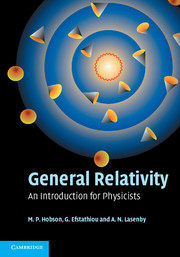Book contents
- Frontmatter
- Contents
- Preface
- 1 The spacetime of special relativity
- 2 Manifolds and coordinates
- 3 Vector calculus on manifolds
- 4 Tensor calculus on manifolds
- 5 Special relativity revisited
- 6 Electromagnetism
- 7 The equivalence principle and spacetime curvature
- 8 The gravitational field equations
- 9 The Schwarzschild geometry
- 10 Experimental tests of general relativity
- 11 Schwarzschild black holes
- 12 Further spherically symmetric geometries
- 13 The Kerr geometry
- 14 The Friedmann–Robertson–Walker geometry
- 15 Cosmological models
- 16 Inflationary cosmology
- 17 Linearised general relativity
- 18 Gravitational waves
- 19 A variational approach to general relativity
- Bibliography
- Index
11 - Schwarzschild black holes
Published online by Cambridge University Press: 05 September 2012
- Frontmatter
- Contents
- Preface
- 1 The spacetime of special relativity
- 2 Manifolds and coordinates
- 3 Vector calculus on manifolds
- 4 Tensor calculus on manifolds
- 5 Special relativity revisited
- 6 Electromagnetism
- 7 The equivalence principle and spacetime curvature
- 8 The gravitational field equations
- 9 The Schwarzschild geometry
- 10 Experimental tests of general relativity
- 11 Schwarzschild black holes
- 12 Further spherically symmetric geometries
- 13 The Kerr geometry
- 14 The Friedmann–Robertson–Walker geometry
- 15 Cosmological models
- 16 Inflationary cosmology
- 17 Linearised general relativity
- 18 Gravitational waves
- 19 A variational approach to general relativity
- Bibliography
- Index
Summary
In our discussion of the Schwarzschild geometry, we have thus far used the coordinates (t, r, θ, φ) to label events in the spacetime. In this context, (t, r, θ, φ) are called the Schwarzschild coordinates. Moreover, until now we have been concerned only with the exterior region r > 2µ. We now turn to the discussion of the Schwarzschild geometry in the interior region r < 2µ, and the significance of the hypersurface r = 2µ. We shall see that, in order to understand the entire Schwarzschild geometry, we must relabel the events in spacetime using different sets of coordinates.
The characterisation of coordinates
Before discussing the Schwarzschild geometry in detail, let us briefly consider the characterisation of coordinates. In general, if we wish to write down a solution of Einstein's field equations then we need to do so in some particular coordinate system. But what, if any, is the significance of any such system? For example, suppose we take the Schwarzschild solution and apply some complicated coordinate transformation xµ → x′µ. The resulting metric will still be a solution of the empty-space field equations, of course, but there is likely to be little or no physical or geometrical significance attached to the new coordinates x′µ.
One thing we can do, however, is to establish whether at some event P a coordinate xµ is timelike, null or spacelike.
- Type
- Chapter
- Information
- General RelativityAn Introduction for Physicists, pp. 248 - 287Publisher: Cambridge University PressPrint publication year: 2006



